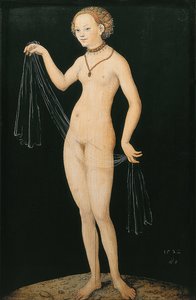Art is a reflection of society and shows the change of values. When Lucas Cranach the Elder was born near Nuremberg at the end of the 15th century, major upheavals were imminent. Italy was under the influence of the Renaissance and in Germany Martin Luther was to herald the Reformation. Painting workshops developed in the association of the guilds. The brush was regarded as a tool and letterpress printing made reproduction possible. Cranach decided on an artistic education related to wood printing. The destination of his journeyman's journey was to be Vienna. Vienna was regarded as the cultural centre north of the Alps. In the imperial court artists found patrons of the arts and financially strong clients. In the artists' group of the Danube School, Cranach gained a view of an independent nature. The figures in his works were decorated with scenes of nature that often had a symbolic meaning and were as expressive as they were dramatic.
Lucas Cranach the Elder became a successful artist. Already at a young age he was appointed court painter. Lucas the Elder founded his own workshop and enjoyed the freedom to determine the number of his employees himself. The artist created a powerful company for himself, enjoyed the financial aspect and social prestige. Wittenberg became the centre of his life and the artist made the acquaintance of Martin Luther. From then on, Cranach devoted himself to the production of altarpieces and paintings that decorated Lutheran churches. The artist took the liberty not to sign his works. A short LC and later the seal of his coat of arms adorn the paintings and woodcuts. Until today a clear determination of his complete works is not completed. This is aggravated by the fact that his son Lucas, when Cranach the Younger took over the workshop and continued the work with the same signature.
The Italian painters of the Renaissance were concerned with the representation of the human body. Anatomical studies were incorporated into the depiction of bodies, and regardless of clothing, the proportions and body shapes became lifelike. Naked bodies in art needed a context. The nudity of Adam and Eve was biblically justified. Ancient gods were allowed to decorate the works of artists without covers if it was of scenic importance. Titian created his Venus during this time. Lucas Cranach the Elder painted the first standing Venus north of the Alps. Lightly veiled by a transparent veil, Cupid accompanies the goddess. Cranach takes up the idea of the Italian Renaissance and Venus shows herself to the observer as a beautiful woman. Cranach made different versions of his Venus. Lucas Cranach the Elder was a master of duplication. His talent for the art of printing enabled him to leave behind one of the most comprehensive works of the Renaissance period.
×




.jpg)
.jpg)
.jpg)
.jpg)
.jpg)
.jpg)
 - (MeisterDrucke-58724).jpg)
 - (MeisterDrucke-58724).jpg)
.jpg)
.jpg)
.jpg)
.jpg)
.jpg)
.jpg)
 1529 - (MeisterDrucke-302567).jpg)
 1529 - (MeisterDrucke-302567).jpg)
.jpg)
.jpg)
 - (MeisterDrucke-60261).jpg)
 - (MeisterDrucke-60261).jpg)
.jpg)
.jpg)
.jpg)
.jpg)
.jpg)
.jpg)
.jpg)
.jpg)


 1528 - (MeisterDrucke-80738).jpg)
 1528 - (MeisterDrucke-80738).jpg)
.jpg)
.jpg)
.jpg)
.jpg)
 Johann the Steadfast (1468-1532) and Johann Friedrich the Magnanimous (1503-54) 1532 - (MeisterDrucke-79546).jpg)
 Johann the Steadfast (1468-1532) and Johann Friedrich the Magnanimous (1503-54) 1532 - (MeisterDrucke-79546).jpg)
.jpg)
.jpg)


.jpg)
.jpg)
.jpg)
.jpg)
.jpg)
.jpg)
.jpg)
.jpg)
.jpg)
.jpg)
.jpg)
.jpg)
.jpg)
.jpg)
 mother of Martin Luther - (MeisterDrucke-50238).jpg)
 mother of Martin Luther - (MeisterDrucke-50238).jpg)
.jpg)
.jpg)
.jpg)
.jpg)
.jpg)
.jpg)
.jpg)
.jpg)
.jpg)
.jpg)
 1543 - (MeisterDrucke-45340).jpg)
 1543 - (MeisterDrucke-45340).jpg)
.jpg)
.jpg)
.jpg)
.jpg)
.jpg)
.jpg)
.jpg)
.jpg)
.jpg)
.jpg)
.jpg)
.jpg)
.jpg)
.jpg)
.jpg)
.jpg)
.jpg)
.jpg)
 - (MeisterDrucke-243448).jpg)
 - (MeisterDrucke-243448).jpg)
.jpg)
.jpg)
.jpg)
.jpg)
.jpg)
.jpg)
.jpg)
.jpg)
.jpg)
.jpg)
.jpg)
.jpg)
.jpg)
.jpg)
.jpg)
.jpg)
_Father_of_Martin_Luther_(pencil_und_wc_on_pa_-_(MeisterDrucke-284766).jpg)
_Father_of_Martin_Luther_(pencil_und_wc_on_pa_-_(MeisterDrucke-284766).jpg)
 - (MeisterDrucke-27947).jpg)
 - (MeisterDrucke-27947).jpg)
 - (MeisterDrucke-134551).jpg)
 - (MeisterDrucke-134551).jpg)
.jpg)
.jpg)
.jpg)
.jpg)
.jpg)
.jpg)
_-_(MeisterDrucke-1070698).jpg)
_-_(MeisterDrucke-1070698).jpg)
.jpg)
.jpg)
.jpg)
.jpg)
 - (MeisterDrucke-142166).jpg)
 - (MeisterDrucke-142166).jpg)
 and Philipp Melanchthon (1497-1560) 1543 - (MeisterDrucke-43725).jpg)
 and Philipp Melanchthon (1497-1560) 1543 - (MeisterDrucke-43725).jpg)
.jpg)
.jpg)
.jpg)
.jpg)
 - (MeisterDrucke-83706).jpg)
 - (MeisterDrucke-83706).jpg)
_-_(MeisterDrucke-1554329).jpg)
_-_(MeisterDrucke-1554329).jpg)
 - (MeisterDrucke-131609).jpg)
 - (MeisterDrucke-131609).jpg)
.jpg)
.jpg)
.jpg)
.jpg)
.jpg)
.jpg)
 - (MeisterDrucke-75705).jpg)
 - (MeisterDrucke-75705).jpg)
.jpg)
.jpg)
.jpg)
.jpg)
 - (MeisterDrucke-89380).jpg)
 - (MeisterDrucke-89380).jpg)
.jpg)
.jpg)
 - (MeisterDrucke-43615).jpg)
 - (MeisterDrucke-43615).jpg)
 - (MeisterDrucke-44118).jpg)
 - (MeisterDrucke-44118).jpg)
.jpg)
.jpg)
 Elector - (MeisterDrucke-259689).jpg)
 Elector - (MeisterDrucke-259689).jpg)
.jpg)
.jpg)
.jpg)
.jpg)
.jpg)
.jpg)
.jpg)
.jpg)
_Father_of_Martin_Luther_-_(MeisterDrucke-57985).jpg)
_Father_of_Martin_Luther_-_(MeisterDrucke-57985).jpg)
.jpg)
.jpg)
.jpg)
.jpg)
 - (MeisterDrucke-98705).jpg)
 - (MeisterDrucke-98705).jpg)
.jpg)
.jpg)
.jpg)
.jpg)
.jpg)
.jpg)
.jpg)
.jpg)
.jpg)
.jpg)
.jpg)
.jpg)
.jpg)
.jpg)
 1532 - (MeisterDrucke-112521).jpg)
 1532 - (MeisterDrucke-112521).jpg)
.jpg)
.jpg)
.jpg)
.jpg)








